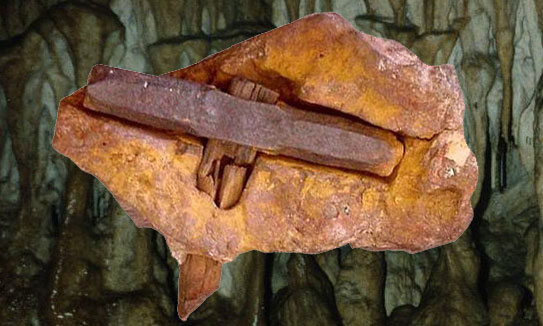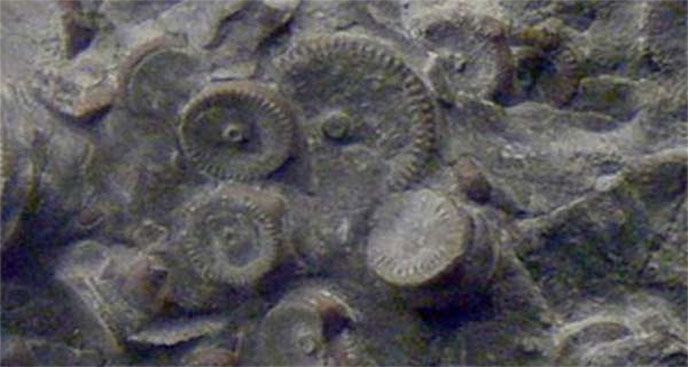
Certainly the study of the distant past of our species is full of surprises. “In 1844, Brewster reported that a nail and a hammer has been discovered firmly sunk in a block of sandstone in the quarry of Kingoodie, at Mylnfield, Scotland.” (source)Cremo and Thompson, Forbidden Archeology
Sir David Brewster (1781-1868) is a well-known scottish physicist who founded the British Association for Science Progress, and who made importantes discoveries in the optic field. Sir Brewster was a sharp scientist, a trustworthy man. That is why he started investigation on this issue outside of his specialty.
400 Million Year Hammer
“Dr. A. W. Medd, from the british centre for geolological research, informed us by mail in 1985, that this rock belonged to an “old inferior red sandstone” aged of 360 to 408 million years.” (source)Cremo and Thompson, Forbidden Archeology
Please note that the datation of this devonian sandstone, and so the hammer, corresponds exactly to the time when dinosaurs reign on Earth. Did one of them lose it while repairing the house’s roof?
To be truly honest, we must say this: petrification could be a lot quicker than we usually think. At Trôô, near Montoire-sur-le-Loir, visitors can see a petrifying cave. They can lay down a nail there, or other wooden or metallic objects, and those ones are changed into stone in a few months time, thanks to both an accurate temperature and a wet atmosphere, saturated with alkaline or limestone vapors. But as far as we know, that’s not the case in Kingoodie.
Certainly, the study of our past is very bad posture. The scholars have made their scenario, and everything that does not fit, they fall into boxes with a label: “singularity”. Voila, the singularity will end on the third basement in its forgotten dusty box. Trying to blow this non-scientific practice, I started to draw the catalog of some archaeological singularities. In fact, this entire website is built on the staggering sum of singularities that science rejects with no reason and that paint a very different picture of our fabulous past.

With your permission, I continue this inventory. In 1885, in a german mine, a cubic object was found in a block of coal extracted from a 60 million year old layer. We could hold the object in one hand, a deep groove surrounded it in the middle. Studies showed that this smelting cube had been casted. But the scientific community decided to ignore it, as if it never existed. Some researchers questioned the authenticity of its origin: couldn’t it be made in a nowadays smelting works? (source)Fossil meteorite found in coal, C.Gurlt, Nature London, 11/11/1886, p.36; L’astronomie, 1886, p.463
In 1890, in California, mortar with pestle made of stone, spear points and a flint axe were found by J. H. Neale, road work operator for the Montezuma tunnel company. He discovered that in the gravel under lava while piercing the tunnel. These manufactured objects were located in 33 to 55 million year old geological layers. Of course, scientists dislike this stunning discovery and the object disappeared, probably on auction’s occasion. There is also a job lot of metal pipes unearthed in China. They are ordinary pipes, except the fact they are 150,000 years old!!
We feel as if science was myopic. Or suffered from a selective blindness. We feel as if scientists lost their sensible way when entering the lab, and adopted the motto: “Here, we do not think. We just research.” We could laugh about it, if it was not so ridiculous.
Steel And Nickel Artifacts
In 1936, some excavations made at the borders between China and Tibet, in the Bayan-Kara-Ula mountain massif revealed 716 stone discs 1 to 1.7 feet in diameter. These discs, pierced in the middle, looked like modern vinyl discs. A groove was spiraling them from edges to center. They were estimated 12 000 years old and they held metal marks. “Dr. V. Zaitsev reported this could be writing signs and that these discs vibrated in certain conditions as if they carried an electric charge. The whole report about these discs is preserved in the Historical Archives in Taipeh, Taiwan, and in the Academy of Pekin.” (source)Top Secret magazine Antediluvian DVDs, how amazing, but we can see remains of more ancient technologies: the mysterious balls in South Africa. In South Africa, near Ottosdal, miners excavated in 30 years time almost 200 metallic round objects. Drs McIver and Bisshoff, geological experts, studied these objects: they are flat spheres with an average diameter of 1 to 4 inches, blue as steel, with red reflections and little white grooves.
![Boule de Klerksdorp, Klerksdorp Sphere - By Robert Huggett (Own work) [Public domain], via Wikimedia Commons - https://commons.wikimedia.org/wiki/File:Ottosdal2.jpg klerksdop-sphere-Ottosdal-688po](https://eden-saga.com/wp-content/uploads/klerksdop-sphere-Ottosdal-688po.jpg)
They are made of steel and nickel, in a way that cannot be found in nature, so they are no meteorites, but true artifacts. Some of them, accidentally broken, were made of a spongy material, transforming into dust in contact with air. They were extracted from a 2.8 to 3 billion years old geological layer, being confirmed by isotopic datation. 3 billion years ago, our plante was still a child. If life had appeared then, it was in unicellular form. So where do these undenyable artifacts come from?
Science considers them as singularities: nobody excepts them entering any scientific theory. It would lead to a distortion of the usual concepts, what would be unconceivable. Generally, ‘serious’ researchers manage to lost such embarrassing singularities. This time, it was fortunately not the case. The mysterious balls are displayed at the south african museum in Klerksdorp, where everyone can admire them. R. Marx, the museum curator, made this stunning statement about them: “Mysteriously, whereas they are imprisoned in their display cabinet, they still spin around slowly.” (source)Les découvertes impossibles, ldi5.com
Prehistoric Mechanics
It also has wheels and other mechanical parts that seem to spring from the most remote past, in the middle age of the dinosaurs. Certainly it is hardly conceivable keen on these big beasts of mechanics and technology. Yet Russian archaeologists from the University of St. Petersburg made a very strange discovery in the Kamchatka Peninsula, 200 km from Tigil: dated fossils 400 million years which included metal gears and parts that seem made in our modern factories.

According to archaeologist Yuri Golubev, the nature of this discovery has baffled scientists: totally unusual, this could bring a drastic change to History -or Prehistory. Come on, Mr. Golubev, this is not the first time a seemingly modern artifact broke in prehistory. See the hammer of dinosaurs,on top for example.
The Lanzhou Stone
A black stone, small pear-shaped, extremely hard and of unknown nature was discovered in China. This stone could be a meteorite, but the amazing thing is that his broken revealed a screw or metal device dated 300 million years. Once more dinosaurs! The Lanzhou Morning News’ published on 26 June 2002 that: “A dozen geologists and physicists of the National Bureau of Territorial Resources and other mining and environmental institutions met to try to discover the origin of this mysterious stone. Following the discussions, the unanimous committee retained the hypothesis of an artifact, holding his invaluable archaeological research in China and in the world “
Neolithic Aluminium
Last but not least: a 20,000 year old metallic wedge was found in the district of Aiud, Romania. This issue should have started a huge protest among scientific community: once more, facing elsewhere, they all keep quiet. Nevertheless this metallic part is very special : it is aluminium. Hear this: aluminum wasn’t fully produced until the 19th century …
The best way to find no proof is not looking for.
![Crâne - collection du Musée de Préhistoire des gorges du Verdon (Quinson) Par/By © Service communication du Conseil général des Alpes de Haute-Provence (Own work) [CC BY-SA 3.0 (http://creativecommons.org/licenses/by-sa/3.0)], via Wikimedia Commons Crâne-Musée-Préhistoire-Verdon-688po](https://eden-saga.com/wp-content/uploads/Crâne-Musée-Préhistoire-Verdon-688po.jpg)
“There is, in a museum’s dusty background, a feldstpath block which was found in 1869 in Abbey’s mine, near Treasure City, Nevada, USA. Big as a fist, this amazing stone contained a 2-inch long metallic screw. We could disctinctly see its head and its regular body. Iron-made, it got oxydized, but the heavy stone surrounding it had preserved its delicate outline. The problem is, the feldspath was estimated 20 million years older than man; this disturbing proof was therefore sent to an academy in San Francisco, and science forgot it.” (source)Cremo and Thompson, Forbidden Archeology “Upstairs at the Smithsonian, secured away, is a piece of amber dated at over 10 million years old. It contains a microcircuitry board. My dad was asked to “figure out” what it could do. That’s not possible without removing enough amber to get to the board itself – this they refused to do. The piece was boxed and stored … saw it myself over 40 years ago!” (source)Rip Savage on Facebook
Forgotten By Science
Spielberg must have imagining the last scene of Raiders of the Lost Ark by reading those pages. In a museum’s dusty background, we can see a warehouseman pushing a waggon. On his waggon, carefully nailed down in an anonymous crate, is the Alliance Ark, which will go mouldy among hundreds of similar crates, irredeemably lost and forgotten.

The Big Bazaar of Dates
- Archaeological Singularities
- Dinosaurs And Humans
- The Dawn of Time
- The Lying History
- Uneasy Dating
- Parallels Calendars
- The Universal Lie
- Seven Fake Centuries
- Jesus of Avignon
- What Middle Ages?
- Pompeii 2.0



